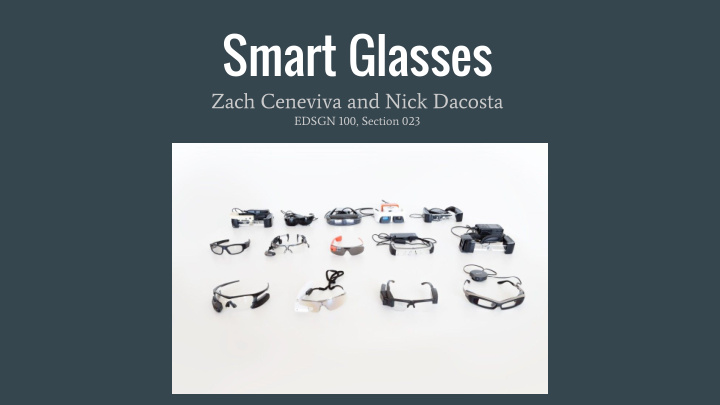



Smart Glasses Zach Ceneviva and Nick Dacosta EDSGN 100, Section 023
What’s to come? What Smart Glasses are ● Who invented Smart Glasses and when ● How Smart Glasses work ● Application ● Availability ● Success ● Ethical considerations ● Augmented Reality vs. Virtual Reality ● Conclusion ●
Smart glasses are a form of augmented reality. Augmented Reality: Adds senses to the ● existing, real environment. Integration of virtuality into the tangible world ● Wearable computer in the form of glasses ● Not currently designed for full time wear ● Human Computer Interface control ●
Smart Glasses are a young piece of technology. First prototyped in late 2012 ● APX Labs has prototyped many Smart ● Glasses, including the first ever Google Glass was a breakthrough for ● Smart Glasses Manufactured by Foxconn ○ Technology Group
Smart Glasses integrates a computer, cameras, and sensors in order to deliver the augmented reality experience. Similar to the components of a smartphone ● Cameras, sensors, GPS, speakers, microphones, CPU ○ Eye tracking helps to determine what the user is looking at ● Mini projectors help to cast virtual 3D objects into the real world ● Access information through apps ● Display on a single eye ● Onboard computer processes all of this information ●
Smart Glasses were created for many purposes. Capture personal experiences from the POV of the user ● Navigate the user on roads or indicate speeding ● Universal remote control with compatible devices through hand gestures ● Sighted companion for blind people by giving them information through ● vibrations Students can view textbooks and virtual 3D worlds ● Promotes playing outside and interaction with others ● Can display performance measurement and comparison ●
Smart Glasses Technology is becoming increasingly more available. There are many units out there already, but very basic in comparison to what is coming ● Many companies have set 2016/2017 as their anticipated release dates ● Prototypes are looking very promising ● Examples: Google Glass, Meta, Atheer One, Vuzix M-100 ($300-$1600) ●
Smart Glasses have seen little success thus far. Google Glass went out of production less than a year after becoming ● commercially available Many laws and legislation surrounding smart glasses have restricted their ● application Not attractive looking ● Technology is not optimized yet ●
Smart Glasses come with several ethical concerns. Privacy issues ● Potential threat of cheating on exams ● Distracting ●
Augmented Reality vs. Virtual Reality Augmented Reality: Surroundings enhanced by the use of virtual objects ● User can see the real world along with the virtual one ● User can interact with the virtual objects ● Virtual Reality: Creates a virtual world where the user can immerse themselves in ● See the virtual world only ● Direct movements affect the virtual world ●
Conclusion Smart Glasses are a form of augmented ● reality Promising technology that comes with ● many ethical dilemmas Hasn’t been extraordinarily successful so ● far Not the same as virtual reality ● Learned what augmented reality is and ● more behind the application and technology of Smart Glasses
References "How Augmented Reality Works." HowStuffWorks . N.p., 19 Feb. 2001. Web. 15 Apr. 2016. "The History of APX Labs, As Told by Smart Glasses: 2011-present." APX Labs . N.p., 24 Apr. 2015. Web. 15 Apr. 2016. "How Do Augmented Reality Glasses Work? - ViewTwoo." ViewTwoo . N.p., 21 May 2015. Web. 15 Apr. 2016. "Google Glass: How Does It Work?" GlassAppSource . N.p., n.d. Web. 15 Apr. 2016. Piltch, Avram. "Glasshole or Not? 7 Urgent Ethical Dilemmas for Wearable Tech." Laptop . N.p., 13 Feb. 2014. Web. 15 Apr. 2016. Schweizer, Hermann. "Smart Glasses: Technology and Application." (n.d.): n. pag. Web. 15 Apr. 2016.
Questions?
Recommend
More recommend